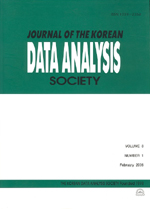한국 신용부도스왑 스프레드의 가격행위
The Behavior Analysis of CDS Price
- 한국자료분석학회
- Journal of The Korean Data Analysis Society (JKDAS)
- Vol.17 No.6
-
2015.123173 - 3183 (11 pages)
- 11

본 연구는 2006년 1월부터 2014년 6월까지 한국 소버린 CDS(credit default swap: 신용부도스왑) 스프레드의 가격행위를 ARCH류의 이산시간 모델이 아닌 평균회귀성과 점프특성을 비교하기 위해 연속시간 모델로 분석하였다 분석결과 첫째, 2008년 금융위기 전과 후의 안정적 시기에는 평균회귀 모형보다는 GBM모형이 적합하였다. 금리(채권 수익률)과 금리 스프레드의 거시경제 변수는 장기추세에 수렴하는 평균회귀적 성격을 갖는 것으로 알려져 있으나 금융위기 전후 경기 안정기에 한국 소버린 CDS 스프레드는 브라운 운동의 GBM 모형을 보였다. 그러나 2008년 금융위기 기간 한국 소버린 CDS 스프레드는 두터운 꼬리의 과도한 첨도를 갖고 있어 점프요소를 모형에 포함시킬 경우 수익률의 변동성이 충분히 반영되었다. 따라서 금융위기 기간에는 평균회귀 모형에 점프요소를 첨가한 결과 모형의 적합도가 높아져 한국 소버린 CDS 스프레드가 시장충격이 사라지면서 빠르게 회복하는 탄력적인(resilient) 가격행위를 갖고 있음을 보였다. 한편, 본 연구는 연속시간모형이 갖는 추정 수렴의 어려움으로 연구기간을 3기간으로 구분되어 분석된 한계가 있다.
This paper empirically investigated the behavior of Korean CDS spread which captures the excess kurtosis and heavier tails (i.e. leptokurtic behavior). In capturing the dynamics of the Korean CDS spread, this study notably focuses on the comparison of mean reverting drifts and jump part of the continuous-time models of CDS spread. The results are as follows. First, Empirical findings indicate that the addition of jumps leads to a lower expected return and volatility. This result implies that jumps account for a substantial portion of the overall volatility of the return data. Second, during pre and post crisis period the GBM is better than competing models in terms of parameter significance, log-likelihood and the BIC. Third, the addition of jumps improves performance significantly since all jump diffusion processes outperform their diffusion counterparts especially during the crisis period. Finally, the addition of mean-reversion appears to increase the goodness-of-fit, especially in the case of the jump-diffusion models during the crisis period.
1. 서론
2. 자료 및 기술통계
3. 한국 소버린 CDS 스프레드의 연속시간모형
4. 방법론 및 실증분석 결과
5. 결론
References
(0)
(0)